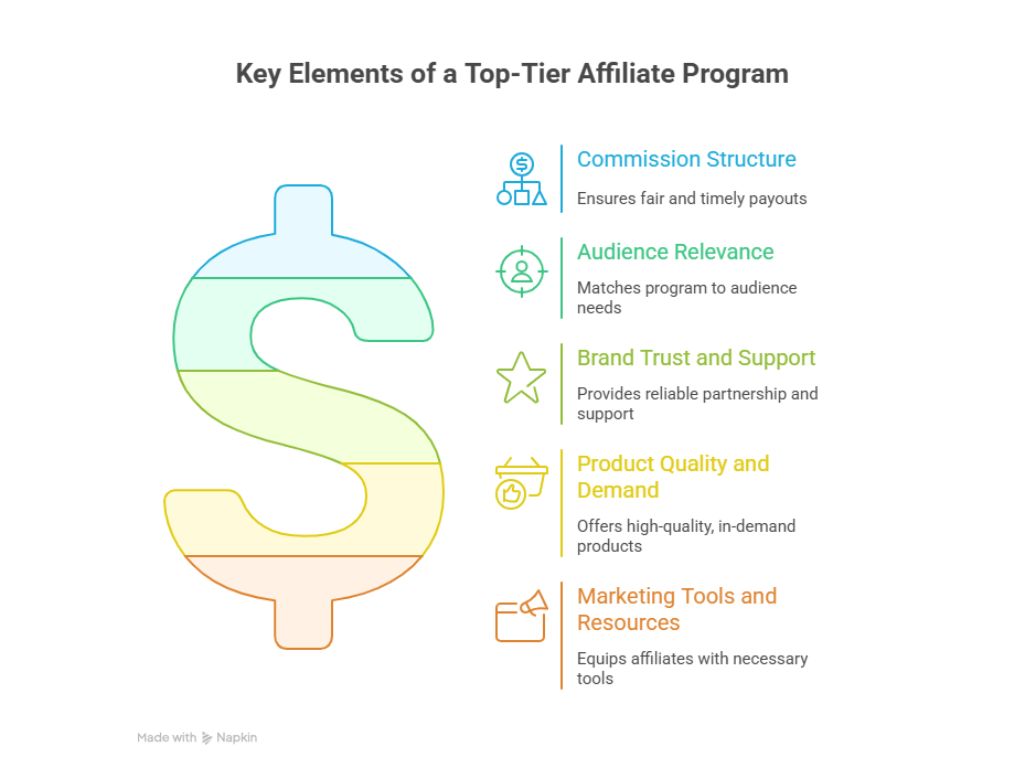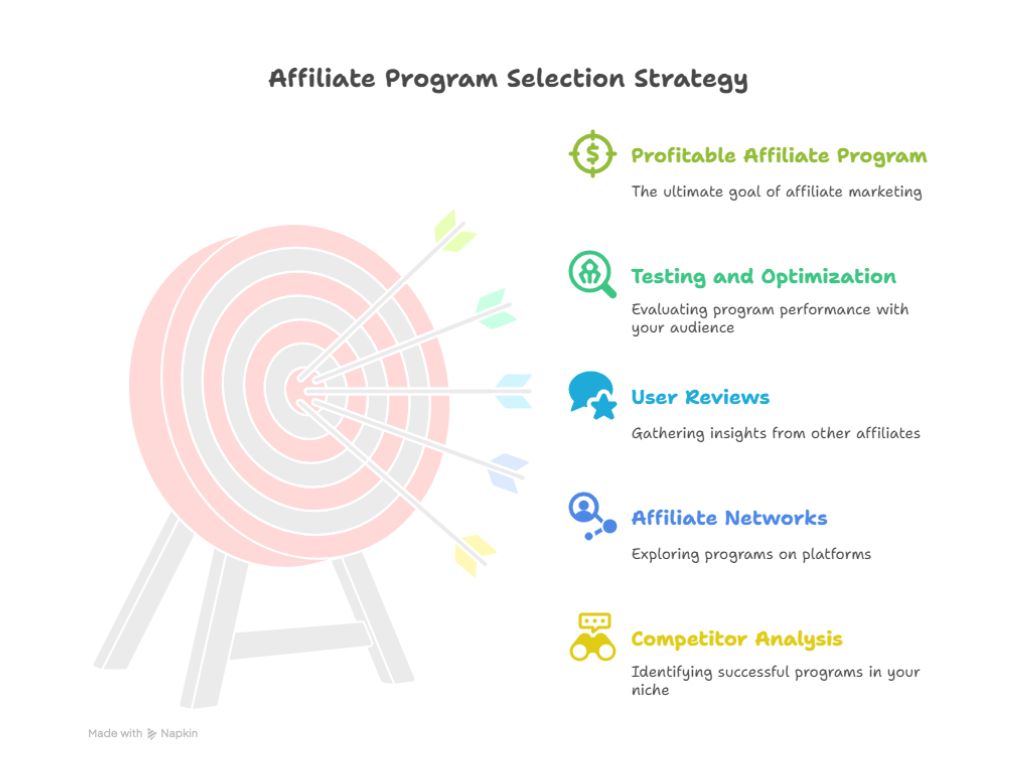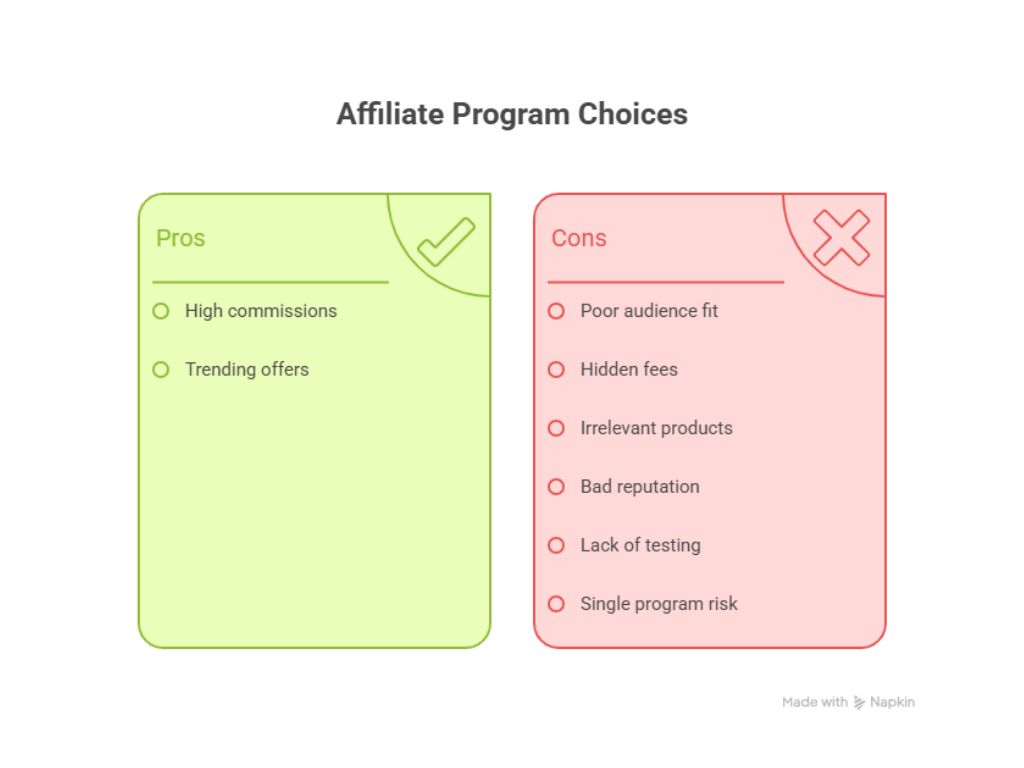Introduction: Why Picking the Right Affiliate Program Is a Game-Changer
Most affiliates never make real money. Why? They chase the hottest new offer, grab the biggest commission percentage, or copy what everyone else is promoting. The result: disappointed audiences, burned-out trust, and earnings that never seem to grow.
Here’s the truth. The best affiliates do not chase. They choose. Picking the right affiliate program for your specific niche is the single biggest shortcut to predictable, sustainable income. Get this right, and your promotions feel effortless. Your audience clicks, buys, and sticks around. Get it wrong, and no amount of hustle will make your results scale.
If you are ready to move beyond trial-and-error, this guide will show you exactly how to choose the best affiliate program for your niche. This single decision can make or break your entire online business.
Key Takeaways: The Core Principles of Picking Profitable Programs
- Not all affiliate programs are created equal; the best fit your niche and solve a real problem for your audience.
- High commissions mean nothing if the product does not convert or lacks trust.
- Longevity matters: the most profitable programs align with your brand, have reliable payouts, and offer ongoing value.
- Your authority grows when you promote only what you believe in and your audience can tell the difference.
- The right program lets you stop hustling for every sale and start building real, predictable income.

What Makes an Affiliate Program “Best” for Your Niche?
The best affiliate program is not just the one with the biggest payout. It is the program that fits your niche like a glove, solves real problems for your audience, and helps you build long-term trust.
1. Commission Structure: Recurring commissions, fair rates, and on-time payouts are crucial. For example, a 30% recurring payout from a subscription tool often outperforms a single high-ticket one-time sale. Look for programs with clear, transparent terms and proven payment history.
2. Audience Relevance: A perfect program matches your audience’s needs. If you run a personal finance blog, a budgeting app will always convert better than a general tech gadget. The tighter the fit, the easier it is to promote without feeling like you are forcing the sale.
3. Brand Trust and Support: Partner only with companies that treat affiliates as true partners. This means responsive support, on-time payments, and a product that consistently earns positive reviews. A brand with a reputation for happy customers and happy affiliates is always the safer bet.
4. Product Quality and Demand: Strong demand and satisfied customers mean higher conversions and lower refunds. Do your research: check third-party reviews, see how long customers stay, and watch for positive social proof. Programs with active communities and ongoing updates also signal quality.
5. Marketing Tools and Resources: The best affiliate programs provide you with email templates, banners, case studies, and deep analytics so you can promote smarter, not harder. Look for a dashboard that tracks clicks, sales, and recurring revenue at a glance.
In short, a top-tier affiliate program is one you are proud to promote because it delivers value to your audience and supports your business for the long term.

How to Research Affiliate Programs in Your Niche
Choosing the right program starts with smart research, not just taking the first offer you see. Here’s how to uncover the programs that fit your niche and pay off long term:
Start With Competitor Analysis: Look at what successful sites and influencers in your niche are promoting. Check their reviews, resource pages, or disclosure statements. If you see certain programs popping up again and again, that’s a sign the offer works and converts.
Dive Into Affiliate Networks: Platforms like ShareASale, CJ Affiliate, Impact, or PartnerStack let you browse hundreds of programs by niche, commission rate, and reputation. Use filters to find offers that align with your brand and audience.
Read Real User Reviews: Don’t just trust official program pages. Dig into forums, independent blogs, or even Reddit to see what affiliates say about payments, support, and conversion rates. Look for red flags, late payments, poor communication, or frequent complaints mean you should steer clear.
Test for Fit and Conversion: Once you’ve narrowed your options, sign up for a few programs and see how they perform with your audience. Track clicks and conversions closely. Sometimes, a lower-commission offer will outperform a high-payout program simply because it’s a better match for your readers.
Stay Alert for Hidden Opportunities: New programs, rising brands, or niche products can be goldmines especially if you catch them before they go mainstream. Being an early promoter can mean less competition and bigger payouts as the brand grows.
The best affiliates do not guess. They research, test, and optimize until they find the offers that truly fit. That’s how you turn affiliate marketing from a side hustle into a real business.
Evaluating Program Terms and Conditions
Smart affiliates know that the fine print can make or break your earnings. Before you commit to any affiliate program, take a hard look at the details that impact your bottom line and long-term success.
Cookie Duration: Longer cookie windows mean more chances to get credit for your referrals. A 30-day cookie is standard, but some programs offer 60, 90, or even lifetime cookies making every click more valuable.
Payment Thresholds and Methods: Check how much you need to earn before you get paid, and how you’ll receive your money. Some programs set high minimum payouts or only pay by check or wire transfer. The best programs let you cash out quickly via PayPal, bank transfer, or other modern options.
Tracking and Attribution: Reliable tracking is non-negotiable. Make sure the program uses trusted software or networks so your referrals never “go missing.” Transparent dashboards with real-time stats give you peace of mind and help you optimize your campaigns.
Geographic Restrictions: Some programs only accept affiliates from certain countries or only pay for sales in specific regions. Double-check eligibility so you do not waste time promoting offers that don’t pay out in your target market.
Payout Reliability: Late payments, surprise policy changes, or unclear terms are warning signs. Look for programs with a track record of consistent, on-time payouts and transparent rules. Read the terms closely and don’t be afraid to reach out to affiliate managers with questions.
A great offer on the surface can turn into a disappointment if the terms work against you. Take the extra time to review the details before you commit and you’ll protect your business, your audience, and your reputation.

Testing and Tracking: Start Small, Optimize Fast
The biggest mistake new affiliates make? Putting all their effort into one program without testing or tracking results. Even the most promising offer on paper might flop with your audience while a lesser-known program could quietly outperform everything else.
Start Small: Promote two or three carefully chosen programs to your audience. Use different links, calls to action, or content formats to see what gets real traction.
Track Every Click and Conversion: Use your affiliate dashboards, Google Analytics, or link tracking tools to monitor performance. Keep records of what you promote, where you place links, and what actually gets results. Don’t guess, let the data guide you.
Split-Test Creatives and Placements: Experiment with banners, buttons, text links, and reviews in different positions on your site, emails, or videos. Small tweaks can make a big difference. Sometimes the highest commissions come from surprising places like a sidebar widget or an in-depth tutorial.
Evaluate and Optimize: After a few weeks, look at your results. Which programs are getting clicks? Which are converting to sales or signups? Double down on what works. Drop or replace what doesn’t.
Keep Testing: Audience interests shift. Offers change. New programs launch. Make testing and optimization a routine, not a one-time event. The affiliates who treat their content and links like a living experiment are the ones who end up with the biggest, most reliable payouts.
Track, test, and tweak and you’ll turn affiliate uncertainty into a predictable, growing income stream.
Common Mistakes Affiliates Make When Choosing Programs
Even experienced affiliates fall into these traps. Avoiding them puts you ahead of the competition and ensures you don’t waste time or trust on the wrong partnerships.
Chasing Hype Over Fit: It’s easy to get seduced by high commissions and trending offers. But if the program doesn’t fit your audience, conversions will tank and your credibility suffers.
Ignoring the Fine Print: Many affiliates skip reading terms and conditions, then get blindsided by short cookies, payment delays, or hidden fees. Always know the rules before you promote.
Neglecting Audience Needs: Pushing irrelevant products to your list or followers is a quick way to lose trust. Only promote programs that genuinely solve your audience’s problems.
Overlooking Brand Reputation: If the company behind the program has a history of late payments or poor customer support, you’ll share in that bad reputation. Research before you commit.
Failing to Test or Track: Promoting blindly without measuring results is a recipe for wasted effort. Always test different programs and track what works.
Not Diversifying Offers: Putting all your energy into a single program is risky. Diversify with complementary offers to build a stable, resilient income stream.
Learn from these common mistakes and you’ll avoid the frustration, lost commissions, and wasted time that trip up so many affiliates.

Case Study: Picking the Right Program for a Specific Niche
Let’s make this real. Imagine you run a fitness blog targeting busy professionals who want to get in shape at home. The affiliate offers you see most often are high-ticket gym equipment, popular supplements, and big-name fitness apps.
Instead of jumping at the highest commission, you start with research:
- Your audience is short on time and values convenience.
- You notice a recurring affiliate program for a streaming workout platform one that offers 30% monthly commissions for every subscriber you send.
- You also see a one-time $100 payout for an expensive piece of home equipment.
You test both:
- You write a review for the streaming workout app and share your personal experience with daily routines. You also feature the gym equipment in a comparison post.
- After one month, your data shows more clicks and signups for the streaming app. The feedback from readers? They love the flexibility and lower price point.
You double down on content about digital fitness solutions, create a beginner’s guide, and include the recurring program in your email welcome sequence.
Result: Your monthly income from the streaming app starts slow, then grows as subscribers renew stacking up without any extra work. Meanwhile, the gym equipment sells occasionally, but the big commission is a one-time win.
Lesson: Choosing the best affiliate program for your niche means knowing your audience, testing for fit, and following the data not just chasing the highest payout.
I believe in transparency, effort, and results. I share only what I’ve tested and proven myself because I know how valuable trust is. My mission is simple: to help others build real, lasting success.
Ismel GuerreroConclusion: The Path to Sustainable Affiliate Income
The best affiliates are not just marketers, they’re matchmakers. They connect their audience with products and services that solve real problems, fit real needs, and earn real trust. That’s how you build a business that grows month after month, instead of chasing a quick win that disappears overnight.
Choosing the right affiliate program for your niche is the single most important move you can make. When you research, test, and optimize for audience fit, everything gets easier: your content converts, your income compounds, and your brand becomes a go-to resource.
Stop guessing, stop chasing hype, and start building with intention. The right affiliate partnerships are the foundation of sustainable, long-term online income. Start your research today and watch your results transform.

FAQs: Choosing Affiliate Programs
1. How do I know if an affiliate program is right for my niche?
Check if the product solves a real problem for your audience, aligns with their interests, and is something you’d genuinely recommend. If it feels natural to promote, it’s usually a strong fit.
2. Are higher commissions always better?
Not always. High commissions are useless if the product doesn’t convert or has low retention. A lower, recurring payout for a product people love can out-earn a big one-time bonus.
3. What red flags should I look for in affiliate programs?
Watch out for short cookie durations, high payout thresholds, unclear terms, delayed payments, or a history of negative affiliate reviews. If a program seems too good to be true, do more research.
4. Can I promote more than one affiliate program at once?
Yes, and you should. Diversifying your offers protects your income and gives your audience more valuable choices.
5. How do I track which programs are actually working?
Use analytics tools, affiliate dashboards, and track every link you share. Compare clicks, conversions, and payouts, then double down on what performs best.
6. Do I need a big audience to make money with affiliate programs?
No. Relevance and trust matter more than audience size. Even a small, engaged list can produce steady income with the right offers.
7. Should I join programs directly or use affiliate networks?
Both approaches work. Networks offer convenience and variety, but direct programs may offer better terms and support. Test both to see what fits your workflow.
0 Comments